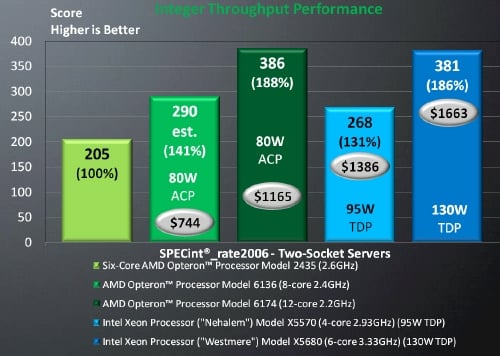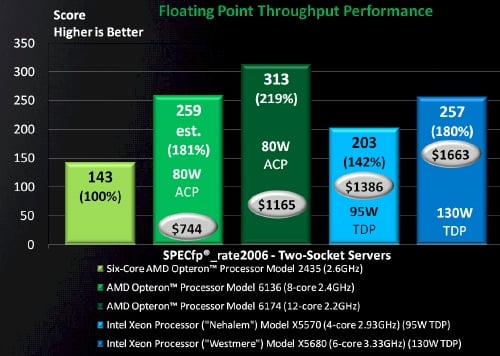This article is more than 1 year old
AMD claims no premium for four-way chips
The Opteron 6100 sales pitch
The question is, can AMD make money at these prices? "Everybody is really concerned about that," admits Fruehe with a laugh. "What we need to do is drive volume, and there's definitely money to be made. And more importantly, our partners can make money with Opteron 6100 machines. The real question is not if AMD can make money, but rather when customers will start calling Intel on the premium it is going to try to charge."
In certain cases, systems based on the eight-core versions of the Opteron 6100s will be the killer box aimed at the two-socket Xeon 5600 boxes. A machine with two of the top-end 3.33 GHz Xeon X5680 six-core processors is rated at 381 on the SPECint_rate2006 integer benchmark and 257 on the SPECfp_rate2006 floating point test; with 48 GB of memory, that machine costs around $3,350.
A reference AMD platform with four sockets using the eight-core 6136 processors running at 2.4 GHz is rated at an estimated 574 on the integer test and an estimated 514 on the floating point test. With 128 GB of memory, that four-socket reference server is expected to cost just under $3,000. (Both machines use 4 GB DIMMs in these comparisons.) That's about 50 per cent more integer performance and double the floating point performance for less money. The AMD 6100 4P box will throw off roughly twice much heat, of course.
AMD is also prepared to go toe-to-toe in the 2P space, both on price and performance. Here's how AMD ranks itself using its standard parts against Intel's standard Xeon 5500 and top-bin (and hotter) Xeon 5600 part:

AMD contends, and is almost certainly right, that Intel mainstreamed the 130-watt (TDP), 3.3 GHz Xeon X5680 merely to have something in the same performance range as the standard 80-watt (ACP, not TDP, so be careful of comparisons on the power draw) twelve-core Opteron 6174.
Here's how the same chips stack up on the SPEC floating point test:

These comparisons, like all made in the IT racket, are imperfect. The mix of ACP and TDP thermal ratings is annoying, and makes it hard to assess who is delivering the best performance per watt and best dollar per performance per watt. But what is clear is that AMD is going to argue that its Opteron 6100 chips offer more performance for the money in roughly the same thermal envelopes as the Xeon 5600s, and it is hard to imagine the gap will not be even larger in bang for the buck for the Xeon 7500s. ®
